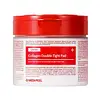What's inside
What's inside
 Key Ingredients
Key Ingredients

 Benefits
Benefits

 Concerns
Concerns

 Ingredients Side-by-side
Ingredients Side-by-side

Water
Skin ConditioningButylene Glycol
HumectantHydrolyzed Collagen
Emollient1,2-Hexanediol
Skin ConditioningGlycerin
HumectantIsopropyl Palmitate
EmollientArginine
MaskingLactobacillus Ferment
Skin ConditioningPrunus Amygdalus Dulcis Oil
Skin ConditioningAcrylates/C10-30 Alkyl Acrylate Crosspolymer
Emulsion StabilisingCarbomer
Emulsion StabilisingPolyglyceryl-10 Laurate
Skin ConditioningDiospyros Kaki Leaf Extract
Skin ProtectingVitis Vinifera Fruit Extract
Skin ConditioningMentha Arvensis Leaf Oil
MaskingCarthamus Tinctorius Flower Extract
Skin ConditioningCoffea Arabica Seed Extract
MaskingPolygonum Cuspidatum Root Extract
AntioxidantCamellia Sinensis Leaf Extract
AntimicrobialCastanea Crenata Shell Extract
Skin ConditioningZanthoxylum Piperitum Fruit Extract
Skin ConditioningLactococcus Ferment
Skin ConditioningBifida Ferment Filtrate
Skin ConditioningBarosma Betulina Leaf Extract
PerfumingDisodium EDTA
Polyquaternium-51
Skin ConditioningRosa Damascena Flower Water
MaskingSodium Hyaluronate
HumectantGluconolactone
Skin ConditioningOenothera Biennis Flower Extract
AstringentPinus Palustris Leaf Extract
TonicPueraria Lobata Root Extract
HumectantUlmus Davidiana Root Extract
Skin ConditioningEthylhexylglycerin
Skin ConditioningGlycine
BufferingSerine
MaskingGlutamic Acid
HumectantAspartic Acid
MaskingLeucine
Skin ConditioningAlanine
MaskingLysine
Skin ConditioningTyrosine
MaskingPhenylalanine
MaskingThreonine
Valine
MaskingProline
Skin ConditioningIsoleucine
Skin ConditioningDipeptide Diaminobutyroyl Benzylamide Diacetate
Skin ConditioningHistidine
HumectantMethionine
Skin ConditioningCysteine
AntioxidantPalmitoyl Tripeptide-5
Skin ConditioningHydrolyzed Hyaluronic Acid
HumectantSodium Acetylated Hyaluronate
HumectantWater, Butylene Glycol, Hydrolyzed Collagen, 1,2-Hexanediol, Glycerin, Isopropyl Palmitate, Arginine, Lactobacillus Ferment, Prunus Amygdalus Dulcis Oil, Acrylates/C10-30 Alkyl Acrylate Crosspolymer, Carbomer, Polyglyceryl-10 Laurate, Diospyros Kaki Leaf Extract, Vitis Vinifera Fruit Extract, Mentha Arvensis Leaf Oil, Carthamus Tinctorius Flower Extract, Coffea Arabica Seed Extract, Polygonum Cuspidatum Root Extract, Camellia Sinensis Leaf Extract, Castanea Crenata Shell Extract, Zanthoxylum Piperitum Fruit Extract, Lactococcus Ferment, Bifida Ferment Filtrate, Barosma Betulina Leaf Extract, Disodium EDTA, Polyquaternium-51, Rosa Damascena Flower Water, Sodium Hyaluronate, Gluconolactone, Oenothera Biennis Flower Extract, Pinus Palustris Leaf Extract, Pueraria Lobata Root Extract, Ulmus Davidiana Root Extract, Ethylhexylglycerin, Glycine, Serine, Glutamic Acid, Aspartic Acid, Leucine, Alanine, Lysine, Tyrosine, Phenylalanine, Threonine, Valine, Proline, Isoleucine, Dipeptide Diaminobutyroyl Benzylamide Diacetate, Histidine, Methionine, Cysteine, Palmitoyl Tripeptide-5, Hydrolyzed Hyaluronic Acid, Sodium Acetylated Hyaluronate
Water
Skin ConditioningButylene Glycol
HumectantMethylpropanediol
Solvent1,2-Hexanediol
Skin ConditioningHydroxyacetophenone
AntioxidantMelaleuca Alternifolia Leaf Water
AntimicrobialLactobacillus Ferment
Skin ConditioningDipotassium Glycyrrhizate
HumectantSodium Citrate
BufferingAllantoin
Skin ConditioningOctyldodeceth-16
EmulsifyingGlycerin
HumectantCitric Acid
BufferingDisodium EDTA
Melaleuca Alternifolia Leaf Oil
AntioxidantHydrogenated Lecithin
EmulsifyingMelaleuca Alternifolia Leaf Extract
PerfumingMangifera Indica Fruit Extract
Skin ConditioningWater, Butylene Glycol, Methylpropanediol, 1,2-Hexanediol, Hydroxyacetophenone, Melaleuca Alternifolia Leaf Water, Lactobacillus Ferment, Dipotassium Glycyrrhizate, Sodium Citrate, Allantoin, Octyldodeceth-16, Glycerin, Citric Acid, Disodium EDTA, Melaleuca Alternifolia Leaf Oil, Hydrogenated Lecithin, Melaleuca Alternifolia Leaf Extract, Mangifera Indica Fruit Extract
 Reviews
Reviews

Ingredients Explained
These ingredients are found in both products.
Ingredients higher up in an ingredient list are typically present in a larger amount.
1,2-Hexanediol is a synthetic liquid and another multi-functional powerhouse.
It is a:
- Humectant, drawing moisture into the skin
- Emollient, helping to soften skin
- Solvent, dispersing and stabilizing formulas
- Preservative booster, enhancing the antimicrobial activity of other preservatives
Butylene Glycol (or BG) is used within cosmetic products for a few different reasons:
Overall, Butylene Glycol is a safe and well-rounded ingredient that works well with other ingredients.
Though this ingredient works well with most skin types, some people with sensitive skin may experience a reaction such as allergic rashes, closed comedones, or itchiness.
Learn more about Butylene GlycolDisodium EDTA plays a role in making products more stable by aiding other preservatives.
It is a chelating agent, meaning it neutralizes metal ions that may be found in a product.
Disodium EDTA is a salt of edetic acid and is found to be safe in cosmetic ingredients.
Learn more about Disodium EDTAGlycerin is already naturally found in your skin. It helps moisturize and protect your skin.
A study from 2016 found glycerin to be more effective as a humectant than AHAs and hyaluronic acid.
As a humectant, it helps the skin stay hydrated by pulling moisture to your skin. The low molecular weight of glycerin allows it to pull moisture into the deeper layers of your skin.
Hydrated skin improves your skin barrier; Your skin barrier helps protect against irritants and bacteria.
Glycerin has also been found to have antimicrobial and antiviral properties. Due to these properties, glycerin is often used in wound and burn treatments.
In cosmetics, glycerin is usually derived from plants such as soybean or palm. However, it can also be sourced from animals, such as tallow or animal fat.
This ingredient is organic, colorless, odorless, and non-toxic.
Glycerin is the name for this ingredient in American English. British English uses Glycerol/Glycerine.
Learn more about GlycerinLactobacillus Ferment is created by fermenting the Lactobacillus bacteria. It helps keep our skin's natural barrier and microbiome healthy.
Studies show lactobacillus ferment to be effective at repairing the skin barrier. Having a healthy skin barrier helps keep your skin healthy and hydrated. It also protects against bad bacteria.
As a probiotic/prebiotic/postbiotic, Lactobacillus ferment can help regular our natural biome. In fact, one study found a lack of diversity in our natural skin biome can trigger acne.
Learn more about Lactobacillus FermentWater. It's the most common cosmetic ingredient of all. You'll usually see it at the top of ingredient lists, meaning that it makes up the largest part of the product.
So why is it so popular? Water most often acts as a solvent - this means that it helps dissolve other ingredients into the formulation.
You'll also recognize water as that liquid we all need to stay alive. If you see this, drink a glass of water. Stay hydrated!
Learn more about Water